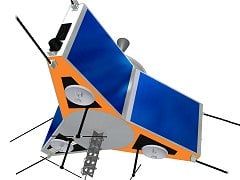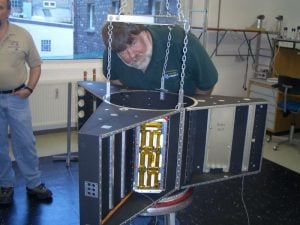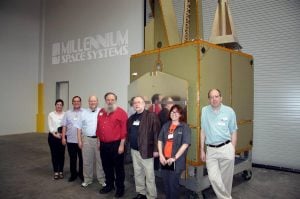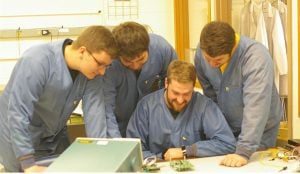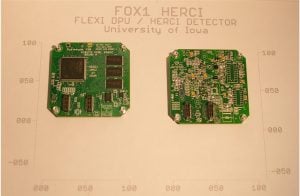During the Dayton Hamvention, AMSAT Vice President Operations, Drew Glasbrenner, KO4MA, and AMSAT Vice President – Engineering Jerry Buxton, N0JY, provided more information about the Fox-1 satellites under development. Buxton, N0JY, says Fox-1A has passed all environmental testing and is integrated into the P-POD deployment canister. “The ‘remove before flight pin’ has been pulled, the doors closed on the P-POD, and everything is aboard the shipping container now en route to Vandenberg Air Force Base in California for launch”, said Buxton.
Previously Buxton had announced plans to incorporate an L band receiver in Fox-1C and Fox-1D. The addition will allow ground commanded selection of the U/v (normal Fox-1 bands) or the new L/v 1.2 GHz (23 cm) mode. Both bands will operate as FM single channel. (See: http://www.amsat.org/wordpress/?p=4000)
During the satellite operations segment of the AMSAT Forum Glasbrenner provided the details of the uplink and downlink frequencies for the Fox-1 FM cubesat fleet.
Fox-1 Frequencies
Uplink FM (67 Hz tone) Downlink FM
Fox-1A 435.180 MHz 145.980 MHz
RadFxSat/Fox-1B* 435.250 MHz 145.960 MHz
Fox-1C* 435.300 MHz 145.920 MHz
1267.300 MHz ** 145.920 MHz
Fox-1D* 435.350 MHz 145.880 MHz
1267.350 MHz ** 145.880 MHz
* Pending IARU Coordination, If needed, changes will be announced
** U/v and L/v operations switchable by command station,
not operational simultaneously
According to Buxton, the team is planning to have an affordable L band uplink ground station available to amateurs by the time Fox-1C is on orbit.
+ Fox-1A will launch on a NASA ELaNa flight scheduled during the third quarter, 2015 from Vandenberg AFB. Fox-1A is a passenger aboard this launch driven by the schedule of the primary payload. When updates are available with firm dates they will be announced via the ANS bulletins, on the AMSAT web, and in the AMSAT Journal.
+ Fox-1B will fly with the Vanderbilt University radiation experiments expected in 2016.
+ Fox-1C will launch on Spaceflight’s maiden mission of the SHERPA multi-cubesat deployer on a SpaceX Falcon 9 flight planned for late 2015.
+ Fox-1D is a flight spare for Fox-1C. If not needed as a spare it will fly with the University of Iowa HERCI radiation mapping experiment.
+ Fox-1E “Evolution” will carry a Mode J linear transponder. The transponder is planned to be 30 kHz wide and will also have a 1200 bps BPSK telemetry beacon. Launch opportunities are being developed, to be announced at a later date.
Visit the Station and Operating Hints page (http://www.amsat.org/wordpress/?page_id=2144) for a copy of the Fox-1 Operating Guide which premiered at Dayton.
AMSAT has an immediate need to raise funds to cover both the launch contract and additional materials for construction and testing for Fox-1C. Please help us to continue to keep amateur radio in space. Donations may be made via the:
+ Paypal and credit card payment on the AMSAT website at http://www.amsat.org/wordpress
+ Donation link in the AMSAT store: http://store.amsat.org/catalog/
+ Call the AMSAT office at (888) 322-6728
